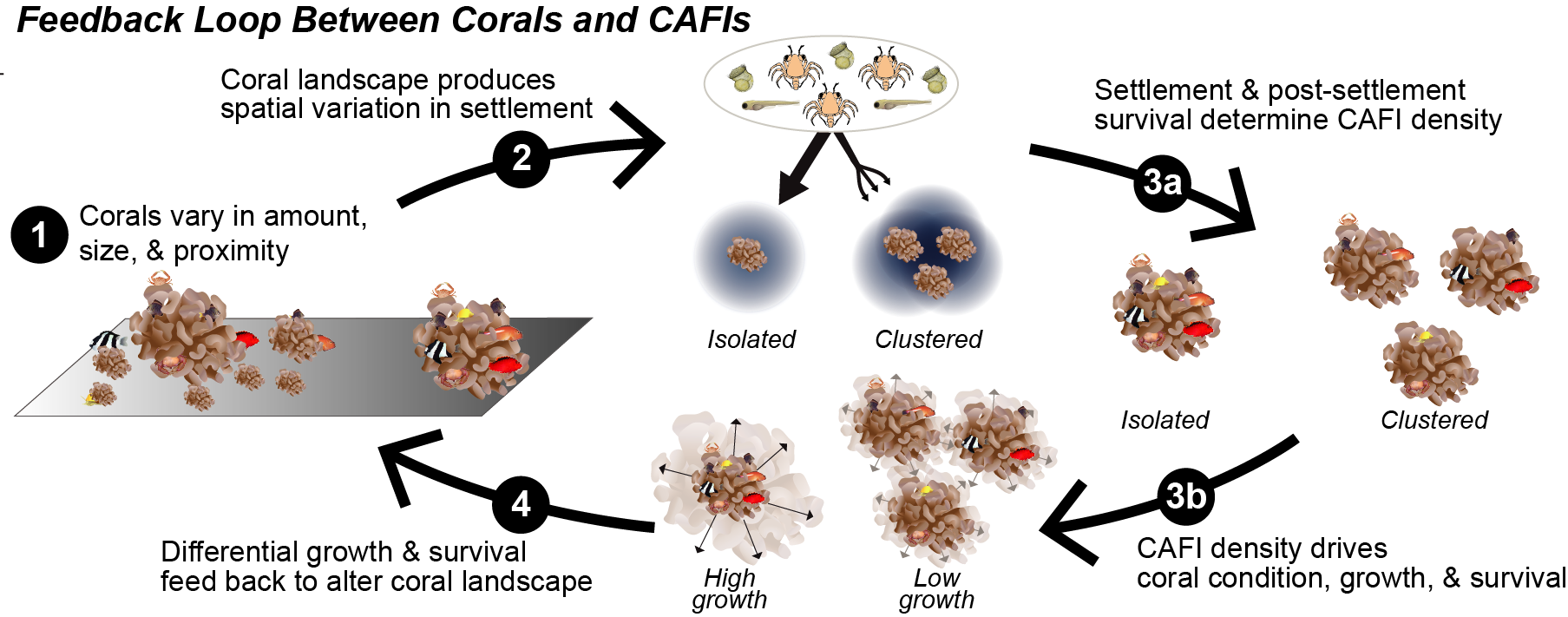 Our collaborative grant on coral-associated-fish&invertebrates (CAFI) and the feedbacks between CAFI and corals builds on the field experiment led by Adrian (Stier and Osenberg 2010) and the modeling work led by Elizabeth (Hamman et al. 2017) and is collaborative between UCSB (Adrian Stier), Tulane (Scott McKinley), and UGA (CWO). Elizabeth will be the post-doc on the project. The Osenberg lab will be recruiting a new student (for 2020) to work on the project and conduct research in Moorea.
Our collaborative grant on coral-associated-fish&invertebrates (CAFI) and the feedbacks between CAFI and corals builds on the field experiment led by Adrian (Stier and Osenberg 2010) and the modeling work led by Elizabeth (Hamman et al. 2017) and is collaborative between UCSB (Adrian Stier), Tulane (Scott McKinley), and UGA (CWO). Elizabeth will be the post-doc on the project. The Osenberg lab will be recruiting a new student (for 2020) to work on the project and conduct research in Moorea.
Abstract: Many nearshore marine ecosystems are defined by habitat-forming species (e.g., kelp, oysters, and coral) that provide shelter and food to other organisms. As a result, spatial variation in the amount, size and distribution of the habitat-forming species plays a central role in determining patterns of abundance and diversity of the species that occupy the habitat. However, many occupants of biogenic habitat also affect the dynamics of the habitat (e.g., by consuming or fertilizing the habitat). The proposed research addresses the feedbacks between corals in the genus Pocillopora (an important biogenic habitat) and the coral-associated fishes and invertebrates (CAFI) that depend on this coral for their persistence. The project uses field surveys, mesocosm and field experiments, and mathematical models to investigate the feedbacks in the coral-CAFI system by: (1) quantifying variation in the coral-CAFI spatial landscape; (2) testing the effects of habitat attributes (coral density, size, and proximity) on the settlement of CAFI and on the distribution of signals used by larvae to locate habitat; (3) testing the effects of habitat attributes on CAFI density (incorporating effects on settlement and post-settlement processes) and on coral condition, growth, survival, and the services that CAFI provide to the coral; and (4) extrapolating these shorter-term effects to understand long-term (e.g., multi-decadal) dynamics. This will be accomplished by building, parameterizing, evaluating, and applying a model that translates short-term experimental results into predictions of coral-CAFI dynamics on larger temporal and spatial scales. The model will be used to evaluate how coral ecosystems recover from disturbances, in light of the coral-CAFI feedbacks.
The mechanisms that underlie the effects of habitat configuration on the density of its occupants remain poorly understood. The proposed research tackles this problem by proposing and testing a mechanism (embodied in “propagule redirection”) that has the potential to explain diverse empirical relationships between habitat amount, patch size, and proximity on occupant density. Furthermore, the feedbacks that arise from the effects of occupants on their habitat is largely absent from past studies of landscape dynamics. Because variation in habitat attributes drives variation in occupant densities, and because this variation in occupant density likely drives the dynamics and distribution of the habitat itself, this feedback is a critical, albeit currently missing, component of landscape ecology. Enhancing the understanding of the feedback loops between organisms and their habitat will offer novel insights into the creation of spatial patterns and the consequences of habitat loss and fragmentation that ecosystems are currently experiencing.